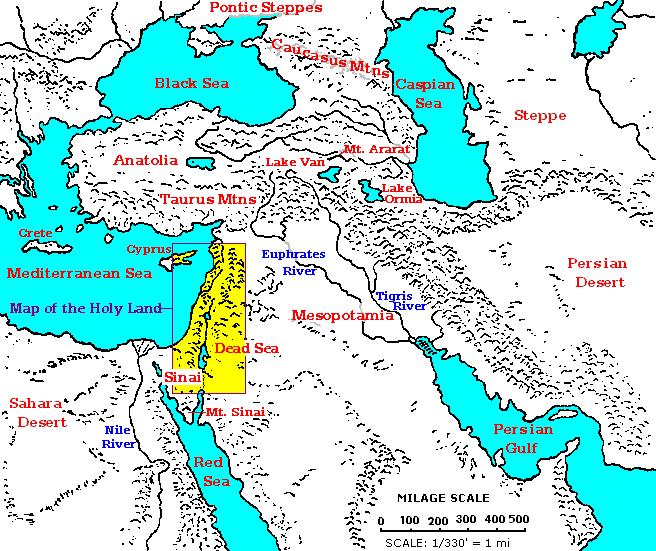Prepare Ye the Way
The Bible Lands

The Bible Lands
Summary
The lands of the Biblical peoples include in a small area of the globe some of its most varied country - its lowest land and some of its higher peaks, rich valleys and barren deserts. The land itself influenced the clash of cultures and wills in which the religion of the Old Testament was formed.
Sea: The Mediterranean Sea was an effective barrier to inland people like the Amorites and Assyrians and an open road for sea empires like Minoa and Phoenicia and later Greece. The sheltered Red Sea and Persian Gulf were valuable tradeways for Egypt and Sumer.
Desert: The Sahara sheltered the civilization of the Nile. The Arabian Desert which had no such life-giving river sustained many small bands of nomads at its oases, spilling them into more cultivated areas when population and new cultural demands grew too great for that harsh land to support. To the east the Persian Desert was a barrier at first, but its northern area merging into the grassy steppes east of the Caspian Sea proved an open highway to the chariot nomads of the steppes, routing one invasion after another into the Fertile Crescent.
Mountains: The Caucasus between the Black Sea and the Caspian Sea was a formidable series of ranges higher than the Rockies. The area abounded in metals: here smelting and metallurgy probably began. They sheltered kingdoms like Urartu around Lake Van, and many other ancient groups of people in the upland country long isolated from the spread of civilization. The Caucasus blocked the expansion of the Pontic (north of the Black Sea) Steppe people into Mesopotamia and delayed by centuries their arrival via the Persian plateau. To the east of the Persian Gulf, extending northward almost to the Caucasus lay the crests of the Zagros Mountains. Their northern slopes, high enough to moderate the blistering heat, watered by rain and many small streams, host to abundant plant and animal life, were nurseries for the Neolithic revolution in the Near East. This hospitable land saw some of the earliest agricultural settlements and villages. These Hill people were left behind when civilization developed between the great rivers of the plain but retained a fierce independence and a readiness to exploit any weakness of the cities. Other mountains were also important. The Greek islands, the tops of long-drowned mountains, included a quiescent volcano which formed the island Thera. The Taurus and other ranges circled the central plateau fastness of Anatolia, the jagged interior of Greece turned its people toward the sea to prosper; the harsh hills of the Sinai sheltered the isolated Israelites as they forged a Covenant with their God.
The People: In the time before civilization developed in the mid-east, there were four main language-culture groups in the area. Egyptian, one of the Hamitic languages of Africa, prevailed in the Nile region. The Semitic language groups were established in Arabia. The Hattites (the native pre-Hittite peoples of Anatolia) and the peoples of the Caucasus Mountains belonged to another ancient language group which can be called Caucasian. Many sub-groups of this language and culture would later enter history as Hurrians, Kassites, and Elamites. The Sumerians of South Mesopotamia, whose language group has never been identified, may also be of this family. To the north from origins at the mouth of the Danube, a group of farming people speaking an Indo-European mother tongue had begun a remarkable expansion up the river and into Europe. As civilization rose in Sumer and Egypt, the Indo-Europeans spread eastward as well, moving to the edge of the Caucasus and north around the Caspian Sea.
The Semitic people s spread from northern Arabia through the whole Syrian area at the end of the Mediterranean. Semitic Akkadian came to dominate the northern Mesopotamian area and under Sargon the Great around 2300 even briefly conquered Sumer itself. At about the same time, the pressure of the Indo-Europeans was being felt in the Bible Lands. A western branch had moved into Greece, and the people known as the Hittites were moving into the older Hattite culture of Anatolia. An eastern branch of the family, the Iranians, was occupying the steppes and circling the Caspian Sea.
Posted by John  Read more
Read more  Comments (15)
Comments (15) ![]() 17.01.
17.01.